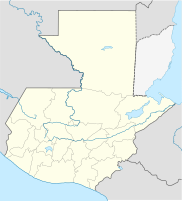Petapa
| Petapa | ||
|---|---|---|
|
Coordinates: 14 ° 30 ′ N , 90 ° 34 ′ W Petapa on the map of Guatemala
|
||
| Basic data | ||
| Country | Guatemala | |
| Department | Guatemala | |
| City foundation | 1831 at today's location | |
| Residents | 101,242 (2002) | |
| Detailed data | ||
| surface | 30 km 2 | |
| Population density | 3,375 inhabitants / km 2 | |
| height | 1260 m | |
| Waters | Amatitlán lake | |
| City patron | Michael (Archangel) (Festival: September 29th) | |
Petapa (formerly San Miguel Petapa ) is a small town in Guatemala and the administrative seat of the municipality of the same name in the Department of Guatemala . The place is about 20 kilometers south of Guatemala City at an altitude of 1,260 m.
Municipio
The smallest of the 17 municipalities in the Department of Guatemala, at 30 km², is located in the south of Guatemala City and parts of it are part of its agglomeration . In the southwest, the municipality has access to Lake Amatitlán . It has a total of around 110,000 inhabitants, the majority of whom live in suburban settlements and villages, including Santa Inés.
Neighboring municipalities are Guatemala City in the north, Villa Canales in the east and south, Amatitlán in the southwest across a sea border, and Villa Nueva in the west.
history
Petapa was founded by the Spanish in 1549 about four kilometers southeast of its current location as San Miguel Petapa. In an area known as Taltic or Taltique , Pocomam , originally from Chinautla, were concentrated in the village of Popah (or Popoyá ). The old name Popah , from which Petapa goes back, means "mat". The village of Santa Inés Petapa, where people lived in a slave-like position, also belonged to the village. Also due to the important trade route ( Camino Real ), which led from Antigua Guatemala via San Miguel to the east ( Oriente ), the place soon came to a certain prosperity. On October 9, 1762, the rivers Villalobos, Morán, Molino and Tulujá burst their banks after storms. A tidal wave of mud and tree trunks almost completely destroyed San Miguel Petapa. Not so much because of the destruction, but rather to differentiate themselves from the indigenous population , on January 22nd, 1763, about 500 Ladinos moved about ten kilometers further to the northwest and founded Villa Nueva ("New Town") there. On April 12, 1763, they were followed by indigenous people who founded the new San Miguel Petapa ( Pueblo Nuevo de Patapa ) three kilometers northwest of the old town near Llano de la Majada . The old place, where some long-established Pocomam families stayed, was henceforth called Pueblo Viejo ("Old Village"). Today's Villa Canales arose from it.
The new San Miguel Petapa was destroyed by an earthquake on April 23, 1840. After disputes over real estate matters, the instruction was issued on November 21, 1831 to rebuild the place about a kilometer further northwest in the Valle de la Horca . It is still there today.
See also
Web links
- Diploma thesis on the Odyssey of San Miguel Petapa (Spanish, PDF, 3.21 MB)
